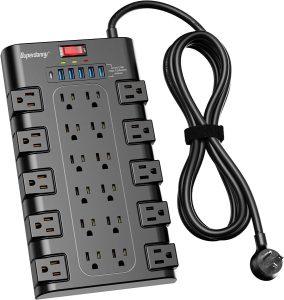Understanding Surge Protectors
A surge protector works by channeling the extra voltage away from the devices it protects, effectively preventing damage that can occur due to sudden spikes in power. These devices become crucial in safeguarding electronic equipment against the potential devastating effects of lightning strikes.
How Surge Protectors Work
Surge protectors use components such as metal oxide varistors (MOVs) to divert excess voltage. Under normal conditions, the MOV allows the electric current to pass through to the connected devices. However, when a surge occurs, the MOV reacts almost instantaneously, redirecting the excess voltage to the grounding wire, thereby protecting the connected equipment.
Key Features of Surge Protectors
- Joule Rating: This indicates the energy capacity of the surge protector. Higher joule ratings offer better protection.
- Response Time: Surge protectors have a response time, usually measured in nanoseconds, indicating how quickly they can react to a surge.
- Clamping Voltage: This is the voltage level at which the surge protector starts to divert electricity away from the connected devices.
Limitations in Lightning Scenarios
While surge protectors are effective against most power surges, their efficiency in handling direct lightning strikes is limited. Lightning strikes can carry an enormous amount of energy, far exceeding the capabilities of standard surge protectors.
Understanding Lightning's Power
- Voltage and Current: A typical lightning strike can deliver over 300 million Volts and 30,000 Amps, massively outstripping the average surge protector's capacity.
- Speed and Energy: Lightning strikes transmit energy in a matter of microseconds, requiring incredibly fast response times from any protective device.
Factors Impacting Surge Protector Effectiveness
- Distance from Strike: The closer a lightning strike is to a structure, the more severe the surge, and the less likely a surge protector will be able to handle it.
- Quality of Surge Protector: Higher quality surge protectors with better specifications can offer more protection against surges but still may not be able to handle a direct or very close lightning strike.

Choosing the Right Surge Protector
When selecting a surge protector, consider the following factors:
Specifications to Consider
- Joule Rating: Look for a high joule rating for better protection.
- Clamping Voltage: Lower clamping voltage means the surge protector will activate sooner.
- Response Time: A lower response time (in nanoseconds) is preferable for quicker protection.
Cost and Quality
- Price Range: Surge protectors can range from $10 to over $100, depending on features and quality.
- Brand and Warranty: Reputable brands often offer better quality and warranties, providing more confidence in the product.
Additional Features
- USB Ports: Some surge protectors include USB ports for charging mobile devices.
- Indicator Lights: These can show whether the surge protector is functioning correctly.
Conclusion
Surge protectors play a critical role in protecting electronic devices from power surges. However, their ability to protect against direct lightning strikes is limited. For the best protection, select a high-quality surge protector with appropriate specifications for your needs and understand that additional measures may be necessary for complete lightning protection.
